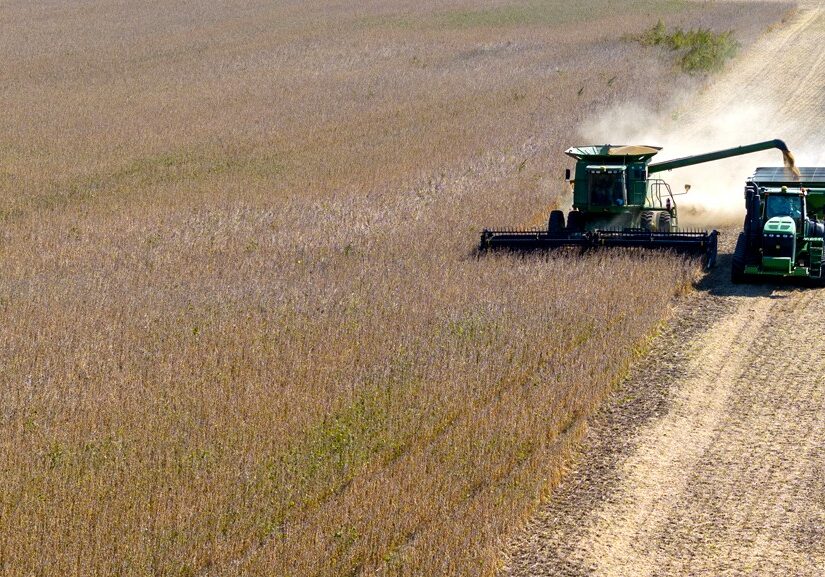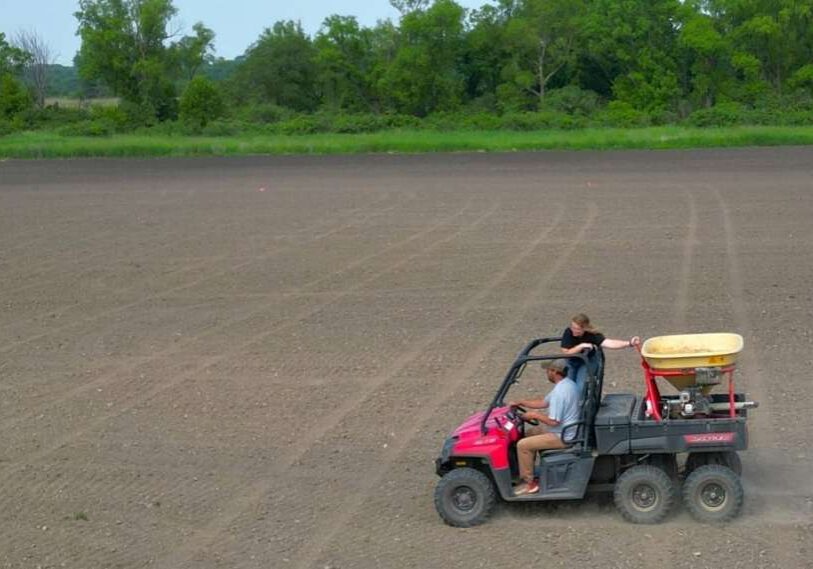An Ancient Crop Makes its Home in Fillmore County
Garlic has been around for more than 5,000 years but arrived in North America relatively 'recently' as European explorers and traders brought it to the New World.

CARIMONA TOWNSHIP/FILLMORE COUNTY – On a cool October day, Paul Schmidt supervised a crew as they planted garlic on his farm north of Preston. The goal is to cultivate 100,000 bulbs of garlic for sale in 2025.
Schmidt’s garlic is sold as seed stock to various garden and seed companies; remaining garlic is marketed for culinary use under Schmidt Farm’s brand at farmers markets and the Schmidt Farm website. In 2024 the Schmidts grew 64,000 bulbs.
In addition to growing hay and conventional row crops, the farm grows and sells asparagus and shiitake mushrooms and offers Farm Stay Vacations to tourists. Schmidt’s wife Karen also produces Fiber Art from the wool of their Icelandic sheep.
A cousin to onions, shallots and leeks, garlic (Allium sativum) is considered one of the oldest cultivated crops on earth, dating back to 3000 BCE. Originating in Central Asia, garlic began appearing in America as early as the 16th century, mainly for use in traditional medicines. Today, garlic is front and center in American cuisine.

Garlic dries from the bottom up, with the bottom leaves forming a seal around the bulb. The stems are left on in the drying process to wick away moisture from the plant. Once dry, stems will be cut and bulbs cleaned before shipping. (Photo by John Torgrimson)
Softneck, hardneck
Although garlic can be grown from seed, most garlic is cultivated by cloning cloves. There are two major crop types: Softneck and Hardneck. Softneck is more suitable for Mediterranean climes with pliable necks that can be easily braided into decorative pieces. Their bulbs are usually smaller yet contain more cloves than Hardneck.
Hardneck garlic is more acclimated to northern climates, as the bulbs are more cold-tolerant. They usually produce a bulb that has 4 to 8 cloves, depending on the variety. There are more than 200 varieties of Hardneck. The Schmidts grow 15 varieties.
Unlike most cultivars, garlic is planted in the fall so that it establishes roots. It is then over-wintered under four to six inches of straw mulch, emerging later as a plant in the spring. Hardneck garlic will develop a seed bulbil (called a scape) that is usually removed so the plant energy will go into developing the garlic bulb. Bulbs are harvested in July and dried for three weeks before being ready for market.

A crew plants garlic in four foot sections, with rows set 10 inches apart. Cloves are planted every six inches. Each set is devoted to a specific variety, with rows 350 feet long. (Photo by John Torgrimson)
Schmidt uses a modified implement on his tractor to till 4 foot wide sections, with rows set 10 inches apart. Cloves are planted every six inches. Each set is devoted to a specific variety, with rows 350 feet long sitting on a 2 ½ acres. Organic certified, Schmidt rotates his garlic fields each year, using cover crops to restore soil health.
Labor intensive
There is limited mechanization associated with garlic cultivation, much of the operation requires manual labor: breaking down bulbs into cloves, planting, mulching, weeding, removing scapes, harvesting, drying, cleaning and shipping all require helping hands.
“It takes longer to break up the bulbs than it does to plant them,” Paul said.
Paul and Karen’s son, Devon, is involved in the farm operation. While Paul was busy with one crew planting, Devon was with another group busily breaking down bulbs into cloves. It took two days to plant the entire 2 ½ acre plot.

Workers break down bulbs into cloves to be planted. Schmidt Farm prepared to plant 100,000 garlic for sale in 2025. (Photo by John Torgrimson)
At the scale that the Schmidts grow garlic, each step in the process requires attention to detail. They converted a former hog facility into a drying room, adding fans and windows.
It takes about three weeks to dry garlic. Garlic dries from the bottom up, with the bottom leaves forming the seal around the bulb. The stems are left on in the drying process to wick away moisture from the plant. Once dry, the stems are removed for ease of storage, then cleaned before shipping.
Over the years, Schmidt Farm has established itself in the marketplace, selling wholesale to seed companies and retail to customers as demand for domestic garlic has grown exponentially.

Schmidt Farm sells 15 types of garlic, mostly hardneck varieties that are more suitable for northern climates. (Photo by John Torgrimson)
Today, the Schmidts have one of the largest organic certified garlic fields in Minnesota. Like the other crops they grow, garlic fits into their overall farm plan.
Paul estimates that they will plant about 1700 pounds of garlic this fall, giving them the potential for four to seven times return when they market the crop in 2025. Each year Schmidt Farm continues to expand production in response to the growing demand for garlic.
Demand created by the likes of Julia Child, Jacques Pépin, Anthony Bourdain and other celebrity chefs has foodies everywhere making garlic a must have in their cooking.
Garlic Tip: Garlic grown domestically will have root stubble on the bottom. The USDA requires all imported garlic to have the stubble removed. Also, imported garlic will have been bleached to prevent it from sprouting.






